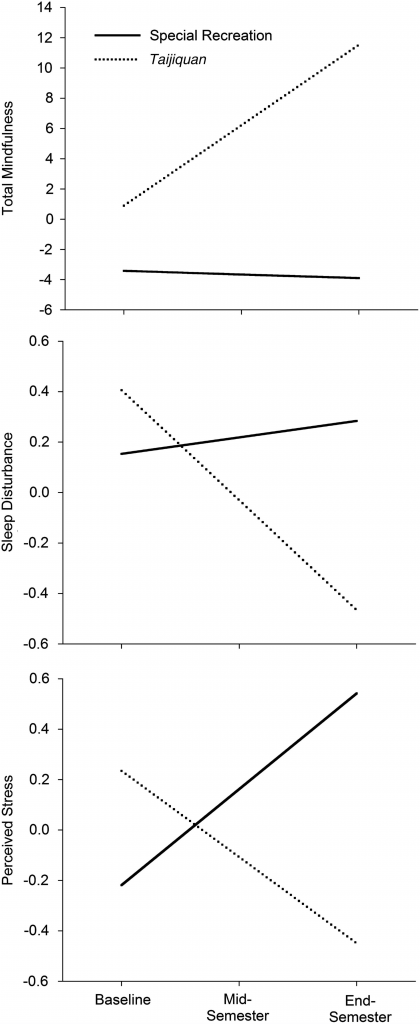Mindfulness and Taiji
September 2022 No Comments Edit
This article describes a clinical trial study that shows how Taiji can improve mindfulness, sleep quality, and overall well being of young adults in colleges. Mindfulness means that the mind is focused on the present task at hand, being aware of the environment but at least for that moment not overly anxious or worry by what is going on around us. Mindfulness can help a person concentrate on the current work, and not get distracted or overwhelmed by other events and the greater environment in which we live.
Mindfulness-Based Stress Reduction (MBSR) was introduced more than 40 years ago by Jon Kabat-Zinn at the University of Massachusetts Medical School, and has become widely recognized and used since then, especially in the last 20 years to help reduce stress and improve overall health. Mindfulness is often associated with meditation and Taiji.
This paper reports on a clinical trial study using Taiji as the method to mindfulness. It compares an experimental group who practices Taiji (Chen-stype Taijiquan) twice a week and a Special Recreation control group who are involved in classes of a similar duration via lectures, discussion, and service learning. Both groups involve ccollege age male and female adults.
Methods: Students in both groups completed in class a survey instrument of five questionnaires at the beginning (baseline), midpoint, and end of the semester. The five questionnaires are
- Mindfulness: The Five Facet Mindfulness questionnaire of 39 items The five factors representing elements of mindfulness are (1) observing or attending to sensations, perceptions, thoughts, and feelings, (2) describing or labeling these internal experiences with words, (3) acting with awareness rather than on “automatic pilot,” (4) nonjudging of inner experiences, and (5) nonreactivity to inner experience.
- Mood: The Four Dimensional Mood Scale is based on a circumplex model of dispositional mood measuring Positive Energy, Tiredness, Negative Arousal, and Relaxation.
- Stress: The Perceived Stress Scale-4 is a 4-item LIKERT format scale designed to measure the degree to which situations in one’s life appraised as stressful.
- Self-efficacy: The Self-Regulatory Self-Efficacy Scale is a 4-item LIKERT format instrument designed to measure self-regulatory self-efficacy (i.e., motivating oneself to keep trying difficult tasks).
- Sleep quality: The Pittsburgh Sleep Quality Index (PSQI) consists of 19 self-rated questions related to normal sleep habits.
Results: The results of this study can be summarized in Fig. 1 and Fig. 2.
Fig. 1 shows the Change in Total Mindfulness, Sleep Disturbance, and Perceived Stress over time for the Taijiaquan Group (dotted line) and the Special Recreation Group (solid line).

Fig. 2 shows the Change in the four mood facets over time for the Taijiquan Group (solid line) and the Special Recreation Group (solid line).

What do these results tell us? Fig. 1 shows significant improvements for the experimental Taiji group as compared to the Special Recreation control group in mindfulness, sleep disturbance and perceived stress. The improvements are significant and improved with time. Similarly, Fig. 2 shows significant improvements for the Taiji group in the four mood facets over time for Positive mood, Negative Energy, Relaxation, and Tiredness. In addition, the significant baseline differences in negative energy and tiredness were reversed by the end of the semester. The study also discussed possible differences between the two groups at baseline but concluded that they do not change the conclusions of the study.
Summary: The main findings of this study support the hypothesis that Taiji classes are associated with increases in mindfulness, well-being and sleep quality among college students. Unlike many Taiji studies which involve mostly senior citizens, an important result of this study is that it investigates young adults. For more recent related studies on mindfulness and Taiji, see Ref. 11 and the articles mentioned in that review.
Acknowledgement: I want to thank Dr. Karen Calwell for permission to reprint Fig. 1 and Fig. 2 of her 2010 article (Ref. 1].
[1] K. Caldwell, l. Emery, M. Harrison, and J. Greeson “Changes in Mindfulness, Well-Being, and Sleep Quality in College Students Through Taijiquan Courses: A Cohort Control Study”: The Journal of Alternative and Complementary Medicine, 920210 17:931-938 https://www.ncbi.nlm.nih.gov/pmc/articles/PMC3199537/, If you are not a subscriber of this journal, you can access a free copy of this article at the above link.
[2] See, e.g., J. Kabat-Zinn “An out-patient program in Behavioral Medicine for chronic pain patients based on the practice of mindfulness meditation: Theoretical considerations and preliminary results.” General Hospital Psychiatry, 1982: 4, 33-47.
[3] J. Kabat-Zinn, Full Catastrophe Living (Revised Edition): Using the Wisdom of Your Body and Mind to Face Stress, Pain, and Illness, 2013 , Bantam.
[4] In the last two decades, there have been many scientific papers on mindfulness and its relationship to health. See, e.g., M. A. Henning, C. U. Krageloh and C. Webster, “Mindfulness and Taijiquan,” Annals of Cognitive Science 2017m 1(1):1-6. For more references, see also M. Henning, et. al., “Integrating Mindfulness and Physical Excercises for Medical Students: A Systematic Review.”
[5] For a more recent article on Mindfulness and Taiji, see D. M. Tow, “Mindfulness, Children’s Social and Emotional Health, and School Initiative”: Https://www.dontow.com/2020/09/mindfulness-childrens-social-and emotional-health-an-school-initiative.
[6] Baer RA, Smith GT, Hopkins J, et. al. Using self-report assessment methods to explore facets of mindfulness. Assessment 2006l13L27-45.
[7] Huelsman TJ, Nemanick RC, Munz DC. Scales to measure four dimensions of dispositional mood: Positive energy, tiredness, negative activation, and relaxation. Educ Psychol Meas 1998;58:804-819.
[8] Cohen S, Kamarck T, Mermelstein R. A global meaaure of perceived stress. J. Health Soc Behav 1983;24:385-396.
[9] Harrison MB, McGuire FA. An investigation of the influence of vicarious experience on perceived self efficacy. Am J Recreation Ther 2008;7:10-16.
[10] Buysse DJ, Reynolds CF, Monk TH, et. al. The Pittsburg Sleep Quality Index: A new instrument for psychiatric practice and research. Psychiatry Res 1989; 28:193-213.
[11] M. A. Henning, el. al., “Mindfulness in Tai Chi Chuan as Practised amongst Higher Education Students with Implications for Health and Learning: A Narrative Review”, OBM Integrative and Complementary Medicine, 2021, V.6, Issue 4.
